Native
Archips fervidana (Clemens) (Tortricidae: Tortricinae: Archipini)
Common name: oak webworm moth
Synonyms: palludana (Tortrix), paludana (Tortrix)
FWLFWL:
forewing length; the distance from the base of the forewing to the apex, including fringe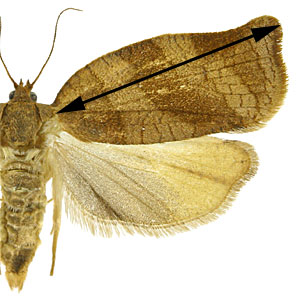 : 7.0-9.5 mm (males); 9.0-10.5 (females)
: 7.0-9.5 mm (males); 9.0-10.5 (females)
Head and thorax orange; forewing with ground color orange, median and terminal fasciafascia:
a dark transverse band on the forewing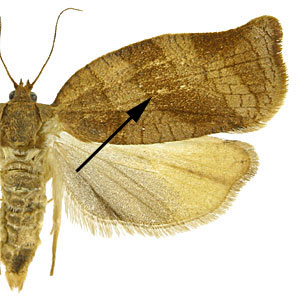 dark brown to black along costacosta:
dark brown to black along costacosta:
the anterior margin of each wing  , obsolete towards inner margininner margin:
, obsolete towards inner margininner margin:
see dorsum 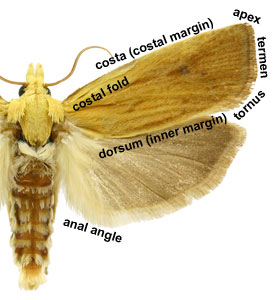 , a large black spot present at end of cell, heavily suffused with dusty gray scaling, especially towards termentermen:
, a large black spot present at end of cell, heavily suffused with dusty gray scaling, especially towards termentermen:
the outer edge of the forewing  ; male with narrow forewing costal foldforewing costal fold:
; male with narrow forewing costal foldforewing costal fold:
a flap or fold at the base of the forewing that contains specialized sex scales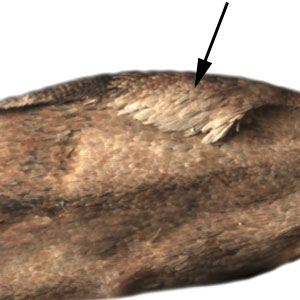 ; hindwing gray.
; hindwing gray.
Male genitalia characterized by broad, circular valvaevalva:
an appendage flanking the intromittent organ that is used to clasp the female during copulation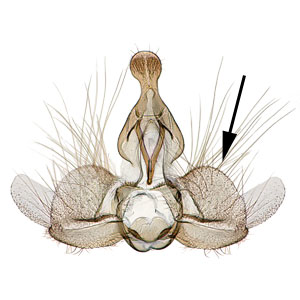 ; a moderate, finger-like uncusuncus:
; a moderate, finger-like uncusuncus:
a sclerotized process which is fused to the posterodorsal margin of tergum IX ; and a pistol-shaped uncusuncus:
; and a pistol-shaped uncusuncus:
a sclerotized process which is fused to the posterodorsal margin of tergum IX . Female genitalia are characterized by a bowl-shaped sterigmasterigma:
. Female genitalia are characterized by a bowl-shaped sterigmasterigma:
the sclerotized region surrounding the female ostium bursae  and long, dagger-like signumsignum:
and long, dagger-like signumsignum:
a sclerotized projection or patch on the interior of the corpus bursae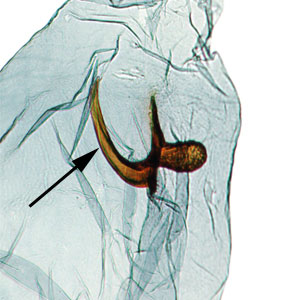 .
.
The following account is summarized from MacKay (1962a).
Mature larvae approximately 20-22 mm in length, width of head on average 1.6 mm. Head dark brown; prothoracic shieldprothoracic shield:
a sclerotized plate on the dorsal surface of the prothorax 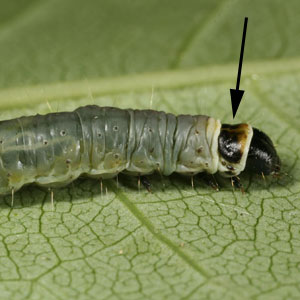 , anal shieldanal shield:
, anal shieldanal shield:
a sclerotized plate on the dorsal surface of the last abdominal segment (in larvae) 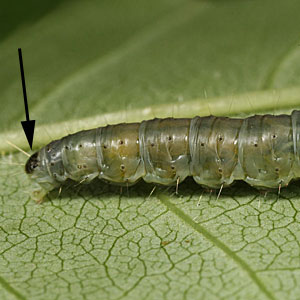 , and legs dark brown; pinaculapinaculum:
, and legs dark brown; pinaculapinaculum:
flattened sclerotized plates on a caterpillar that bear the setae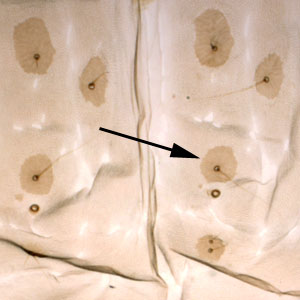 moderate in size, brown; body gray-green in living larvae, brownish in preserved larvae; anal fork absent. SV group on A1, 2, 7, 8, 9 usually 3:3:3:2:2.
moderate in size, brown; body gray-green in living larvae, brownish in preserved larvae; anal fork absent. SV group on A1, 2, 7, 8, 9 usually 3:3:3:2:2.
A more complete description of the larval chaetotaxychaetotaxy:
the arrangement of setae (in reference to Lepidoptera larvae), often depicted on a "setal map"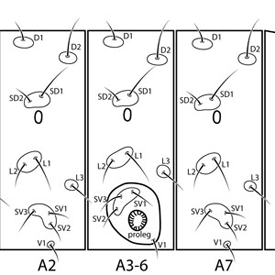 is available in MacKay (1962a).
is available in MacKay (1962a).
Archips fervidana is similar to A. infumatana (Zeller) and A. cerasivorana (Fitch), but A. infumatana possesses much darker forewings and A. cerasivorana can be distinguished by its orange hindwings.
Little is known about the biology of A. fervidana beyond the host plants listed below. Oak (Quercus spp.) appears to be the preferred host. Freeman (1958)Freeman (1958):
Freeman, T. N. 1958. The Archipinae of North America (Lepidoptera: Tortricidae). Canadian Entomologist, Supplement 7 (Vol. 90): 1-89. reports that at least some instars are partially social, with larvae “living in small webs covered with frass.” Adults have been recorded from July through August, suggesting a single generation per year.
| Host plant | Host plant family | Reference(s) |
| Quercus alba | Fagaceae | Prentice 1966Prentice 1966: Prentice, R. M. 1966. Vol. 4. Microlepidoptera. In : Forest Lepidoptera of Canada recorded by the Forest Insect Survey. Dept. For. Canada Publ. 1142: 543-840. |
| Quercus macrocarpa | Fagaceae | Prentice 1966Prentice 1966: Prentice, R. M. 1966. Vol. 4. Microlepidoptera. In : Forest Lepidoptera of Canada recorded by the Forest Insect Survey. Dept. For. Canada Publ. 1142: 543-840. |
| Quercus palustris | Fagaceae | Prentice 1966Prentice 1966: Prentice, R. M. 1966. Vol. 4. Microlepidoptera. In : Forest Lepidoptera of Canada recorded by the Forest Insect Survey. Dept. For. Canada Publ. 1142: 543-840. |
| Quercus rubra | Fagaceae | LACM IndexLACM Index: LACM Index. Records from the card file at the Los Angeles County Museum of Natural History, Los Angeles, California; transcribed by Gaeden Robinson (BMNH).; Prentice 1966Prentice 1966: Prentice, R. M. 1966. Vol. 4. Microlepidoptera. In : Forest Lepidoptera of Canada recorded by the Forest Insect Survey. Dept. For. Canada Publ. 1142: 543-840. |
| Quercus sp. | Fagaceae | Forbes 1923Forbes 1923: Forbes, W. M. T. 1923. The Lepidoptera of New York and neighboring states. Primitive forms, Microlepidoptera, Pyraloids, Bombyces. Cornell Univ. Argic. Exp. Sta., Mem. 68. 729 pp.; Meyrick MS 1938Meyrick MS 1938: Meyrick MS 1938. Unpublished manuscript by E. Meyrick at BMNH, data captured by Gaeden Robinson.; Kimball & Jones 1943; Schaffner 1959Schaffner 1959: Schaffner, J. V. 1959. Microlepidoptera and their parasites reared from field collections in the northeastern United States. USDA, Misc. Publ. 767. 97 pp.; Freeman 1958Freeman 1958: Freeman, T. N. 1958. The Archipinae of North America (Lepidoptera: Tortricidae). Canadian Entomologist, Supplement 7 (Vol. 90): 1-89.; LACM IndexLACM Index: LACM Index. Records from the card file at the Los Angeles County Museum of Natural History, Los Angeles, California; transcribed by Gaeden Robinson (BMNH). |
| Quercus velutina | Fagaceae | Prentice 1966Prentice 1966: Prentice, R. M. 1966. Vol. 4. Microlepidoptera. In : Forest Lepidoptera of Canada recorded by the Forest Insect Survey. Dept. For. Canada Publ. 1142: 543-840. |
| Carya sp. | Juglandaceae | Freeman 1958Freeman 1958: Freeman, T. N. 1958. The Archipinae of North America (Lepidoptera: Tortricidae). Canadian Entomologist, Supplement 7 (Vol. 90): 1-89.; MacKay 1962aMacKay 1962a: MacKay, M. R. 1962a. Larvae of the North American Tortricinae (Lepidoptera: Tortricidae). Canadian Entomologist, Supplement 28: 1-182. |
| Prunus sp. | Rosaceae | LACM IndexLACM Index: LACM Index. Records from the card file at the Los Angeles County Museum of Natural History, Los Angeles, California; transcribed by Gaeden Robinson (BMNH). |
| Prunus virginiana | Rosaceae | Prentice 1966Prentice 1966: Prentice, R. M. 1966. Vol. 4. Microlepidoptera. In : Forest Lepidoptera of Canada recorded by the Forest Insect Survey. Dept. For. Canada Publ. 1142: 543-840. |
| Populus tremuloides | Salicaceae | Prentice 1966Prentice 1966: Prentice, R. M. 1966. Vol. 4. Microlepidoptera. In : Forest Lepidoptera of Canada recorded by the Forest Insect Survey. Dept. For. Canada Publ. 1142: 543-840. |
View full screen host table here
Archips fervidana is broadly distributed in the northeastern United States and eastern Canada, from New York and Ontario west to North Dakota and through the Appalachian mountains south to Tennessee and North Carolina. The range of this species is much smaller than that of its host plants, suggesting that climate or habitat may play a significant role in the distribution of this species.